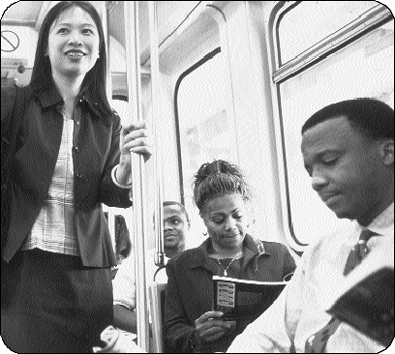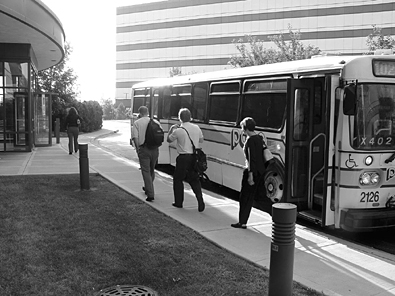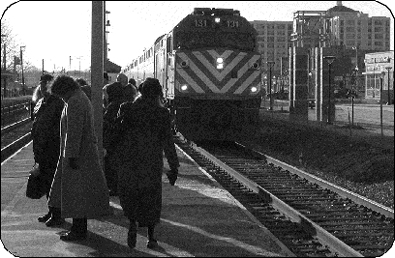Download (164 KB)
It is an unfortunate fact that commuters in northeastern Illinois deal with some of the most congested roads in the nation. Every year, Chicago-area rush-hour drivers spend roughly 61 hours stuck in gridlock, a shocking number that is projected to grow. According to the U.S. Census, between 1990 and 2000, commute times increased by more than 10 percent throughout the region, while the mismatch between where jobs are concentrated and where workers can afford to live created commute patterns that were nearly impossible to cover using public transportation.
By supporting a set of programs that give incentives to employees to live near their jobs and take public transit, employers can play a major role in reversing those trends and improving the quality of life of their workers. At the same time, such incentive programs can allow businesses to make a positive impact on their local communities and reap the bottom-line benefits of expanded tax incentives and a more stable, productive and loyal workforce.
Such employer-led initiatives include:
- Transit benefit programs, which eliminate income and payroll taxes for money spent on employees’ transit expenditures;
- Employer-assisted housing programs, in which employers help their workers buy homes closer to work; and
- Location efficient mortgages, which increase the affordability of homes with access to transportation options.
Taken together, these initiatives offer businesses an opportunity to take a leadership role in addressing the region’s transportation and housing issues. Read on to learn how these programs work, and why they have proven effective for a growing list of area employers.
TRANSIT BENEFIT PROGRAMS
Transit benefits take advantage of part of the federal tax code that allows for commuting expenditures to be excluded from an individual’s income tax. These provisions have been strengthened over time — most recently at the beginning of 2002, when the monthly amount of tax-free transit expenditures was increased to $100.
The benefits can work in different ways. Every month, employees can set aside pre-tax income for either transit or vanpool costs. Employers can supplement funds as a benefit in addition to the employee’s contribution. The program can be any combination of these two options, as long as the total amount for each employee does not exceed $100.
Both employers and their employees stand to save significantly by participating. Employees can save hundreds of dollars on their income taxes by planning their commuting expenditures, while employers benefit through the reduced payroll taxes. This reduction grows as more and more employees join.

Commuters on a Chicago Transit Authority train.
COURTESY OF THE CTA
With low administration costs, such savings are there for the taking for businesses whose employees already use transit to get to work, or for those who want to encourage more employees to choose transit. As a result, transit benefits have become a valued perk for many commuters.
In the Chicago region, the joint program offered by the Regional Transportation Authority (RTA) and Chicago Transit Authority (CTA) makes it easy for businesses to operate a transit benefit program. Each month, employers submit an order to purchase CTA fare cards or voucher checks — depending on the employee’s preference — which can be used to purchase fares for any of the regional transit providers, including the Metra, CTA, South Shore and Pace systems.
Currently, the CTA/RTA program includes more than 1,800 enrolled businesses and 40,000 employees. Program sales have increased dramatically in the past few years, reaching $57.7 million in 2002 — a 45 percent increase over 2001. And the employers participating range from some of the largest to smallest in the region.
For example, Amalgamated Bank of Chicago, with roughly 200 employees at its downtown Chicago headquarters, has operated its transit benefit program for over seven years. Bank employees are offered $15 each month in transit funds, and can then add pre-tax income up to the amount they plan to spend.
Robert Kressin, the company’s vice president of human resources, estimates that around 90 percent of their headquarters’ employees make use of the tax-free transit, since Amalgamated is easily accessed by both CTA and Metra service. "I think it’s a great perk for our employees. It’s even a big perk for me," he says of the benefit. "People can save a lot by reducing their taxable income, and there is very little administration cost for our company."
And, not all participating companies are located at the downtown hub of Chicago’s transit network. Suburban employers such as Hewitt Associates, an international human resources outsourcing and consulting firm that employs more than 7,000 people at its Lincolnshire headquarters, also sees value in allowing employees to take advantage of transit benefits.
Hewitt has a history of helping employees access their jobs, and offers its transit benefit program to employees at all of their offices nationwide. Locally, Hewitt helps fund the Lake-Cook Shuttle Bug service, which transports commuters from Metra stations to a number of businesses along the Lake-Cook Road corridor.
According to Tim Grzesiakowski, Hewitt’s transportation coordinator, the organization’s transit benefit program has offered another chance for the company to be proactive in its approach to associate transportation. "We were thinking about how we could offer another benefit," he recalls, "and saw that this could also help our recruiting efforts and save some on payroll dollars."
EMPLOYER-ASSISTED HOUSING
Another employer-led initiative with transportation benefits is employer-assisted housing (EAH). As business leaders have realized that helping their employees become homeowners stabilizes their workforce, EAH programs have proliferated. And, because most EAH programs focus on helping employees live near their workplaces — not an easy task in some of the less affordable areas of the region where job opportunities are sometimes concentrated — they can play a key role in reducing employees’ long commutes.
EAH programs can operate in a number of ways, and are customized for the needs of each employer. Most offer financial down-payment assistance that is forgiven over time — as long as the employee stays with the company — in addition to counseling services.
In the Chicago area, employers can tap into the resources of the Regional Employer-Assisted Collaboration for Housing (REACH) to develop an EAH program that works for them. This collection of nonprofit groups has experience setting up programs and conducting employee counseling, which especially helps first-time homeowners navigate the home-buying process.

Participants in the transit benefit program at Hewitt Associates use a Pace bus to get to work in north suburban Lincolnshire.
The employee benefits of EAH are obvious, as the financial assistance can often make the difference between being able to find a home near work and not. But the benefits to employers can be dramatic as well. Experience has shown that savings from the reduced turnover rates attributed to EAH programs can exceed the initial program investment in just one year.
To top it off, the State of Illinois has created incentives that make EAH programs even more compelling. As part of the Illinois Affordable Housing Tax Credit program, employers can earn state income tax credits worth 50 cents for each dollar in benefits given. In addition, a State of Illinois grant will match dollar-for-dollar any EAH assistance given to employees in northeastern Illinois — up to $5,000 depending on household income. Finally, many employers who create EAH programs will qualify for federal tax deductions, because any investment in the program can be written off as donations through one of the many nonprofit REACH organizations.
While most EAH programs in the region are new, even their early returns are encouraging. For example, System Sensor in St. Charles has had an EAH program in place since 2000, and, by September 2003, had successfully helped 43 of their employees become homeowners. The program has the stated goal of helping employees live closer to work, and is thus limited to purchases within a 15-mile radius of the manufacturing plant. An internal evaluation has already shown a $100,000-per-year savings just from reduced turnover rate and absenteeism — an amount that easily pays back the company’s investment in $5,000 forgivable loans for each participating employee.
Similarly, an EAH program started in 2002 by Northwest Community Healthcare in Arlington Heights is helping its employees find affordable housing in the expensive northwest suburbs. The hospital’s program already has 66 enrolled employees, with 10 of them purchasing houses in the program’s first year. In addition to the hospital's goals of retaining employees and building a strong workplace environment, the communities surrounding the hospital have benefited from more stable neighborhoods as a result of greater levels of home ownership.
Sheri Rupert, a chaplain working at the hospital, has utilized the downpayment assistance and homeowner counseling — through REACHaffiliated North West Housing Partnership — to find and purchase an affordable condominium in nearby Palatine.
Now she lives much closer than before, and has cut her drive to work from 45 minutes to 15 minutes each way. "I am in a really great location now, near shopping, the hospital and my church," she explains. "Cutting down significantly on my commute time also helps me to be more readily available if I am urgently needed."
LOCATION EFFICIENT MORTGAGE
Companies interested in helping their employees live near work or utilize public transportation should also be aware of an important, zero-cost program that is increasing housing affordability in transitfriendly neighborhoods — the location efficient mortgage (LEM). Families living near transit generally incur less out-of-pocket transportation costs, as they can walk to local services and may need one car instead of two. Recognizing this, LEMs offer extra home-buying power to individuals purchasing in multi-use neighborhoods situated near public transportation.
Traditionally, mortgage lenders determine what size of loan a homebuyer can qualify for based on ratios that compare income to factors such as housing costs and debt. Based on neighborhood and household characteristics, LEM lending adds potential transportation savings to the household’s income, thus increasing the mortgage size for which a buyer can qualify.

Sheri Rupert, a night chaplain at Northwest Community Healthcare who bought a home through the hospital’s EAH program, was able to move a half hour closer to her job.
For example, a typical household locating in a transit-friendly neighborhood in Chicago could experience "place-related" savings totaling around $400/month. Based on that, a household could qualify for an additional $60,000 in a mortgage through a LEM lender.
In Chicago — where two mortgage lenders have financed more than 40 home purchases using the LEM process — employers interested in taking a proactive role in meeting employee transportation needs should be aware of the opportunity LEMs can provide. Especially for lower-income households that do not rely on cars, LEM lending opens up a wide array of housing opportunities that would otherwise not be possible.
In addition, the continued growth of LEM lending in our region can contribute to the establishment of thriving communities built around public transit — making a transitfriendly lifestyle attainable for more people.
BENEFITS FOR EMPLOYERS AND EMPLOYEES
By supporting innovative programs such as transit benefits, employer assisted housing and location efficient mortgages, employers can exhibit leadership on transportation solutions and help employees afford lifestyles that do not include time-consuming commutes and high transportation costs. In addition, these programs, on a large or small scale, can offer real benefits for employers — especially when considered as a package of employee incentives that help retain workers, improve the workplace environment and invest in the local community.

Because not using an automobile reduces household expenses, people moving to areas served by transit can qualify for bigger loans through location efficient mortgage programs.
Established in 1997 and co-led by the Chicagoland Chamber of Commerce, Metropolitan Planning Council and Chicago Metropolis 2020, the coalition has been an instrumental forum for Chicago-area employers to shape both state and federal funding debates and bring forth solutions to the traffic gridlock that threatens northeastern Illinois. With more than 100 business organization members representing more than 12,000 employers, Business Leaders for Transportation serves as the collective regional voice of business on surface transportation issues.
FOR MORE INFORMATION...
Karyn Romano, Metropolitan Planning Council: 312.922.5616
Rob Nash, Chicagoland Chamber of Commerce: 312.494.6700
Jim LaBelle, Chicago Metropolis 2020: 312.332.2020
Transit benefit programs
RTA transit benefit hotline: 800.531.2828
CTA transit benefit hotline: 312.396.8450.
Samantha DeKoven, Metropolitan Planning Council: 312.863.6021.
Dave Chandler, Center for Neighborhood Technology: 773-278-4800.
MPC is grateful to the Joyce Foundation for its funding of the Business Leaders for Transportation coalition.
We also thank the following for their funding of MPC's Regional Action Agenda, of which Business Leaders for Transportation is a component:
The John D. and Catherine T. MacArthur Foundation
Chicago Community Trust
McCormick Tribune Foundation
Aon Corporation
State Farm Insurance Companies